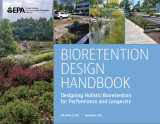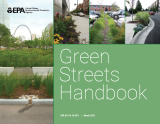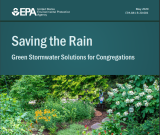Nonpoint Source: Urban Areas
On this Page:
- Introduction
- Low Impact Development
- Urban Runoff Information and Resource Centers
- Other EPA Topic Related Resources
- Additional Urban Runoff Factsheets, Presentations and Reports
319 Grants Across the Country: Water Quality Improvements:
Introduction:
Urbanization increases the variety and amount of pollutants carried into our nation's waters. In urban and suburban areas, much of the land surface is covered by buildings, pavement and compacted landscapes. These surfaces do not allow rain and snow melt to soak into the ground which greatly increases the volume and velocity of stormwater runoff. In addition to these habitat-destroying impacts, pollutants from urban runoff include:
- Sediment
- Oil, grease and toxic chemicals from motor vehicles
- Pesticides and nutrients from lawns and gardens
- Viruses, bacteria and nutrients from pet waste and failing septic systems
- Road salts
- Heavy metals from roof shingles, motor vehicles and other sources
- Thermal pollution from impervious surfaces such as streets and rooftops
These pollutants can harm fish and wildlife populations, kill native vegetation, foul drinking water, and make recreational areas unsafe and unpleasant.
Low Impact Development
The term low impact development (LID) refers to systems and practices that use or mimic natural processes that result in the infiltration, evapotranspiration or use of stormwater in order to protect water quality and associated aquatic habitat. EPA currently uses the term green infrastructure to refer to the management of wet weather flows that use these processes, and to refer to the patchwork of natural areas that provide habitat, flood protection, cleaner air and cleaner water. At both the site and regional scale, LID/GI practices aim to preserve, restore and create green space using soils, vegetation, and rainwater harvest techniques. LID is an approach to land development (or re-development) that works with nature to manage stormwater as close to its source as possible. LID employs principles such as preserving and recreating natural landscape features, minimizing effective imperviousness to create functional and appealing site drainage that treat stormwater as a resource rather than a waste product. There are many practices that have been used to adhere to these principles such as bioretention facilities, rain gardens, vegetated rooftops, rain barrels and permeable pavements. By implementing LID principles and practices, water can be managed in a way that reduces the impact of built areas and promotes the natural movement of water within an ecosystem or watershed. Applied on a broad scale, LID can maintain or restore a watershed's hydrologic and ecological functions.
Low Impact Development Resources & Publications:
You will find fact sheets and technical reports both here and on EPA's Green Infrastructure pages.

Bioretention Design Handbook (pdf) This handbook was developed to inform practitioners about the latest trends and approaches for bioretention design, construction, inspection, and maintenance. The handbook contains a compilation of the current state of knowledge from published literature, interviews, and site visits with leading municipalities and practitioners across the United States. A unique feature of the handbook is the numerous photographs of bioretention facilities from more than 20 municipalities across the contiguous United States that showcase the diversity of design techniques.

Green Streets Handbook (pdf) This handbook is intended to help state and local transportation agencies, municipal officials, designers, stakeholders and others to select, design and implement site design strategies and green infrastructure practices for roads, alleys and parking lots. The document provides background information on street and road typologies and offers a programmatic framework to use when identifying areas that can be initially designed or later retrofitted with green infrastructure practices or systems.

Saving the Rain: Green Stormwater Solutions for Congregations (pdf)
This guide was created to help congregations work through the process of enhancing their grounds by implementing green stormwater management practices. Potential actions include those that can help improve air and water quality, provide habitat for wildlife, improve the aesthetics of the surrounding area, offer a peaceful outdoor sanctuary and make the community more sustainable.
Green Infrastructure in Parks: A Guide to Collaboration, Funding, and Community Engagement (pdf)

This guide is intended to encourage partnerships between park agencies and stormwater agencies aimed at promoting the use of green infrastructure on park lands. Green infrastructure can help to maximize the environmental, economic, and social benefits of parks. It includes recommendations on the types of projects that are most likely to attract positive attention and funding, and which provide a wide range of benefits.
LID Barrier Buster Fact Sheet Series:
- Barrier Buster #1: How LID Can Protect Your Community’s Resources (pdf) (1.3 MB, March 2012, EPA 841-N-12-003A)
- Barrier Buster #2: Terminology of Low Impact Development - Distinguishing LID from other Techniques that Address Community Growth Issues (pdf) (586.46 KB, March 2012, EPA 841-N-12-003B)
Addresses LID’s place in the jumble of terms for managing the environmental impacts of growth that coexist today and describes and distinguishes these terms. - Barrier Buster #3: Costs of Low Impact Development - LID Saves Money and Protects Your Community’s Resources (pdf) (1.71 MB, March 2012, EPA 841-N-12-003C)
Challenges the perception that LID is too expensive. - Barrier Buster #4: Aesthetics of Low Impact Development - LID Technologies Can Benefit Your Community’s Visual Environment (pdf) (1.91 MB, March 2012, EPA 841-N-12-003D)
Challenges the perception that LID is unattractive. - Barrier Buster # 5: Effectiveness of Low Impact Development - Proven LID Technologies Can Work for Your Community (pdf) (1.67 MB, March 2012, EPA 841-N-12-003E)
Challenges the perception that LID doesn't work. - Barrier Buster #6: Maintenance of Low Impact Development - Communities Are Easily Managing LID Practices (pdf) (1.66 MB, December 2012, EPA 841-N-12-003F)
Challenges the perception that LID is too hard or costly to maintain. - Barrier Buster #7: Encouraging Low Impact Development - Incentives Can Encourage Adoption of LID Practices in Your Community (pdf) (492.59 KB, December 2012, PA 841-N-12-003G)
Highlights incentive strategies to catalyze LID. - Barrier Buster #8: Soil Constraints and Low Impact Development - Careful Planning Helps LID Work in Clay Soils (pdf) (1.65 MB, October 2014, 841-R-14-004A)
Challenges the perception that LID can’t work in clay soils. - Barrier Buster #9: Slopes and Low Impact Development - Designing and Siting LID Practices on Slopes (pdf) (622.88 KB, August 2015, EPA 841-R-14-004B)
Challenges the perception that LID doesn’t work in areas with significant slopes. - Barrier Buster #10: Large Volume Storms and Low Impact Development - Using LID Practices in Areas with Intense Rainfall Events (pdf) (3.29 MB, October 2017, EPA 841-F-16-009)
Challenges the perception that LID doesn’t work in areas subject to large volume storms. - Barrier Buster #11: Space Limitations and Low Impact Development - LID Practices are Well-Suited for Small Spaces (pdf) (3.42 MB, August 2018, 841-F-16-010)
Challenges the perception that LID requires a lot of space. - Barrier Buster #12: Revising Local Codes to Facilitate Low Impact Development - Creating LID–Local Development Code Connections Will Assist with Implementation (pdf) (5.47 MB, June 2021, 841-F-19-002)
Addresses what many see as the largest remaining barrier to greater use of LID/GSI: barriers in local development codes that have prevented greater adoption of LID.
Information Resources and Centers
- Center for Watershed Protection The Center for Watershed Protection works with local, state and federal governmental agencies, environmental consulting firms, watershed organizations and the general public to provide objective and scientifically sound information on effective techniques to protect and restore urban watersheds.
- Stormwater Manager's Resource Center The Stormwater Manager's Resource Center (SMRC) is designed specifically for stormwater practitioners, local government officials and others that need technical assistance on stormwater management issues.
- Low Impact Development Center The Low Impact Development Center was established to develop and provide information to individuals and organizations dedicated to protecting the environment and water resources through proper site design techniques that replicate pre-existing hydrologic site conditions.
- American Society of Civil Engineers The ASCE provides a variety of resources to both members and non-members. Visit this site to learn more about upcoming events, current issues and membership opportunities.
- American Water Resources Association The American Water Resources Association is a non-profit professional association dedicated to the advancement of men and women in water resources management, research and education.
- International Stormwater Best Management Practices (BMP) Database This database provides access to stormwater BMP performance data in a standardized format for over 530 BMP studies conducted over the past fifteen years. The database was developed by the Urban Water Resources Research Council (UWRRC) of ASCE under a cooperative agreement with the US Environmental Protection Agency.
- Urban and Coastal Community Conservation Resources The National Association of Conservation Districts provide urban and community conservation resources and give conservation districts and their partners a place to gather information and exchange ideas about their urban and community conservation activities.
- Nonpoint Education for Municipal Officials (NEMO)NEMO provides municipal officials with technical assistance and training in linking land use to water quality.
Other EPA Topic Related Resources
- Smart Growth This site provides information to help create communities that promote the sustainability of America's environment, economy and quality of life.
- Green Infrastructure
- Stormwater
- Greening EPA
- Stormwater Management for Federal Facilities under Section 438 of the Energy Independence and Security Act
- Septic Systems/Onsite Waste Water Treatment
- Water Infrastructure and Resiliency Finance Center provides financial expertise to communities that are financing, drinking water, waste water and storm water infrastructure
Additional Urban Runoff Factsheets, Presentations and Reports
- Guidance for Federal Land Management in the Chesapeake Bay Watershed May 2010. See Chapter 3, Urban and Suburban
- National Management Measures to Control Nonpoint Source Pollution from Urban Areas November 2005. This guidance helps citizens and municipalities in urban areas protect bodies of water from polluted runoff that can result from everyday activities. These scientifically sound techniques are the best practices known today. The guidance will also help states to implement their nonpoint source control programs and municipalities to implement their Phase II Storm Water Permit Programs.
- Guidance Specifying Management Measures for Sources of Nonpoint Pollution in Coastal Waters See Chapter 4, Management Areas for Urban Areas.
- Protecting Water Quality from Urban Runoff (pdf) (220.01 KB, February 2003, EPA 841-F-03-003)
- National Conference on Urban Stormwater: Enhancing Programs at the Local Level (pdf) (21.66 MB, February 2003, EPA/625/R-03/003)
A wide array of effective storm water management and resource protection tools have been developed for urban environments, but their implementation continues to be hampered by a lack of technology transfer opportunities. At the national conference Urban StormWater: Enhancing Programs at the Local Level (February 17-20, 2003), attendees learned about state-of-the-art technologies and implementation programs that have proven success in local communities. - Guidance for Municipal Stormwater Funding (pdf) (612.14 KB, January 2006)
The focus of this guidance is to provide a resource to local governments as they address contemporary stormwater program financing challenges. The guidance includes procedural, legal, and financial considerations in developing viable funding approaches. The guidance examines a range of possible approaches to paying for stormwater management, but the focus is on guidelines for developing service/user/utility fees to support these programs. - Techniques for Tracking, Evaluating, and Reporting the Implementation of Nonpoint Source Control Measures Urban (pdf) (951.52 KB, January 2001, EPA 841-B-00-007)
This guidance is intended to assist federal, state, regional, and local environmental professionals in tracking the implementation of best management practices (BMPs) used to control urban nonpoint source pollution.
